|
|
Search for
The Famous Blonger Bros. |
|

August 2007
| 8/1/2007 |
Green River Whiskey
According to pre-pro.com, a "Web Site Devoted to the Appreciation of Pre-Prohibition Shot Glasses," J.W. McCulloch bought the Green River distillery in 1888. It burned in 1918, but was rebuilt. McCulloch's slogan "The Whiskey Without a Headache" was changed when prohibition ended in response to tougher laws regarding advertising.
-CJ
Fate of the Forest Queen
Finally a clear photo of the mine's former location -- the red dot, methinks.
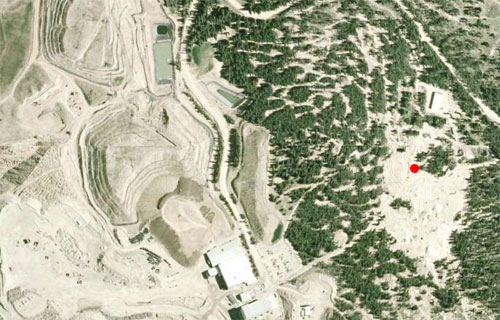
-CJ
|
| 8/3/2007 |
Young Lou
Okay, let's talk about this new article, titled "WHEREIN IT IS SHOWN THAT DENVER'S Bunco King Was A Sucker Himself." As we said, it's undated, though it was obviously published while Lou's death was still in the public consciousness — which wasn't long. The publication, the Evening News was probably a Denver paper.
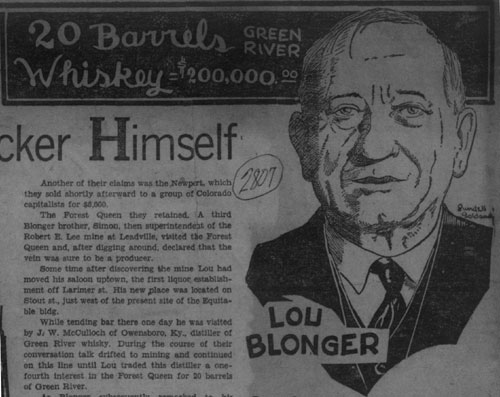
It begins:
Lou Blonger, the human shark who preyed on "suckers," was a sucker himself.
The king of the buncs, as he was known far and wide, disposed of a veritable fortune in order that he might ply his chosen trade of taking the gullible and unsuspecting "hicks" to a trimming.
Had he devoted his energies to lawful pursuits which were open to him he might be alive today with a good fortune to his name instead of being dead; he died while wearing prison garb in the state penitentiary at Canon City.
Tho it cannot truly be said that Lou lived a hand-to-mouth existence, or that he died in abject poverty, he did live in a state of constant fear of law enforcement. On his death he left his widow an almost insignificant estate.
Altho it is not generally known, Lou was the discoverer of a very rich vein of ore, which, if he had retained and mined, would have netted him a generous living and augmented his estate.
I find this a curious angle. I believe Scott and I have always seen Lou as more businessman than con man, keenly focused on the acquistion of wealth by whatever means, legitimate or otherwise. Through his gambling houses he was able to facilitate the bunko trade and take his cut — but it was business, not flamboyance, or ingenuity, or social statement, or the need to tell a cosmic joke, like Doc Baggs, or the Yellow Kid, or Soapy. Lou is described much more often as a grafter than a grifter, but here the writer, Richard Markey, states plainly that Lou had a need to swindle for its own sake, a need for the thrill of the game.
Of course, we have no particular reason to give Markey's assertions particular weight. He is in fact incorrect on a number of counts. But Markey seems to have sources we haven't heard from before, and whoever they might be, they may have passed on some kernels of fact along along with all the chaff.
But to get back some years and to that part of Blonger's life which is not known to the general public, which remembers him only as a slicker - Blonger was one of the early pioneers of Colorado and the old railroadless West.
He was born of a family of hardrock miners at Shellburg, Wis,. then a prosperous mining town. Tales of unlimited gold fields and other opportunities in the West induced Lou to leave his family and follow the advice of Horace Greeley.
A detailed story of his trip west over the plains is lacking, but many incidents attached to it were related by Blonger to his intimate friends.
Now the tale gets taller.
According to the story, Lou with a brother, Sam, left their home in Wisconsin in the '60's, in one way or another they crossed the country to Fort Kearney, Neb. The situation of the brothers became known to General Kearney, who was then in command at the fort.
KEARNEY FORBIDS THEIR TRIP
Because of the active warfare being waged by the Indians in the West against travelers whom they considered were infringing on their preserves, General Kearney refused to allow the youths to continue their trip.
They remained at the fort for nearly six months, during which time their only shoes were worn from their feet. Then, when the opportune time arrived, they left the army garrison and started across country barefooted and with only meager provisions.
Their perilous journey was never discussed at length by either of the brothers. Indians in roving bands were active at the time against all travelers of the plains and many harrowing experiences must have been undergone by the boys.
Now that's just not right. In 1865, at just fifteen, Lou was a fifer in the Union Army, 142nd Illinois. His tour was cut very short when he injured his leg in Tennessee, a wound that would supposedly plague him for the rest of his life. After the war he went back to Illinois and remained in the area until 1869.
Four years after the war, he finally did go west, with Sam, to Red Oak, Iowa (west enough at the time). Lou ran a pool hall, Sam clerked a hotel. It was the beginning of their boomtown journey, Lou and Sam, but this was hardly before the coming of the railroad. It was, in fact, their habit of many years to follow the railroad to its current terminus, some new strike in the desert or mountains.
On the other hand — Sam did, evidently, go west in 1858 or 1859. He signed a petition to that effect in 1860, asking the government to build a bridge across the Snake River to safeguard the passage of settlers. The petition indicated that Sam followed the California Trail, traveling with a group of seventeen wagons via the Lander Road through Wyoming.
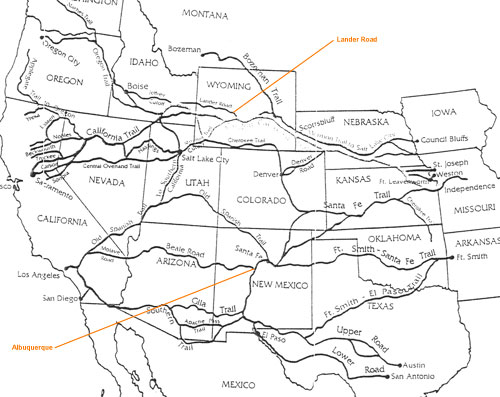
This new tale is in fact a twist on one we've heard before, from Armstrong. Sam goes West at eighteen, walking barefoot through a newborn Denver City. So, though we have good reason to discount the story altogether, there is also a hint of validation, reason enough to investigate. Would the Kearney story — minus Lou — hold up under scrutiny? Will we find General Kearney at Ft. Kearney in 1858 or '59? Might there have been an effort at that time to restrain travelers for fear of Indian attack? Might there even be some record of the fort's residents at that time? There may be something to uncover.
First let's get this straight: Ft. Phil Kearney is in Wyoming, on the Bozeman trail up to Montana. Ft. Kearny is in Nebraska. Sam would have traveled by Ft. Kearny on the Overland Trail.
NebraskaHistory.org has a few short pieces on the fort that generally support its role in Markey's tale.
Fort Kearny rendered many services to the emigrants [during the 1850s]. The troops provided protection against Indian attack. Most of the wagon trains camped a few days in the vicinity of the fort before going on. The necessary shoeing of draft animals and wagon repairing usually took several days, and nearly every train had a number of animals which had to be rested before continuing the journey. Here also letters were written to relatives and friends.
By the time emigrants got to Fort Kearny most of them found that their wagons were too heavily loaded and they began discarding supplies and equipment. A number of them doubled teams and left part of their wagons. Other travelers found themselves in need of food and other supplies by the time Fort Kearny was reached. Most of these had undertaken the journey without enough money to buy the necessary equipment, and some had bought unwisely.
...Emigration continued through the 1850s, with Fort Kearny remaining an established point on the Overland Trail.
This was said of the fort in 1860:
"The military reservation at Ft. Kearny was ten miles square, extending east from the fort eight miles, and west two miles to Dobytown, where there was a cluster of sod and log houses, tents and shacks; a population of possibly 100, as bad a crowd of men and women as ever got together on the plains. There, to gather in a few dollars that were spent by the soldiers and emigrants, knowing that they were safe from the Indians, they lived by preying upon travelers and soldiers. It was here that I saw the first game of poker and faro. A long log building, known in those days as a 'gambling hell,' was wide open, of course. A woman playing an old cracked piano, and three or four fellows playing on a violin and base [sic] viol, and a cornet player, constituted the band--the attraction that drew people into the den. Here I saw them throwing three card monte and playing probably every game that was known to the gambling profession in those days. Fortunately I did not have a cent to spend, . . .
In any movie worth its salt, the preceding would dramatize Sam's inroduction to the wild side.
"During our day's stop-over at Ft. Kearny I saw the pony express rider going westward at the rate of ten miles an hour. I learned that the first pony express rider had left St. Joseph, Missouri, at 5 P.M., April 3, 1860, about ten days previous to my first acquaintance with the pony express rider."
Funny he should mention that. To continue with Markey:
They continued their journey to Salt Lake City, where, after a time, Lou got work as a rider for the Wells-Fargo Express Co. His duties in this position were to ride the stage coaches and guard the gold bullion carried from the flourishing western mining camps to the U.S. mint at San Francisco. He worked at this for a time, while his brother Sam worked in Nevada mines, which produced some of the gold which was shipped under Lou's protection.
After Red Oak, Sam and Lou did indeed move on to Salt Lake City. In Lou's words: "In 1870 went with my Brother to Utah was with him until 1875 resided at Dry Canon, Stockton and Salt Lake. During those years, at Salt Lake was treated by Dr. Hamilton for varicose veins and ulcers in left leg."
In these Utah mining towns Sam and Lou had businesses including the Omaha Beer Saloon, and a canned oyster distributorship. Other businesses too, surely, and perhaps mining claims. They were said to have had a steamship on the lake offering entertainment, though no evidence of this has surfaced.
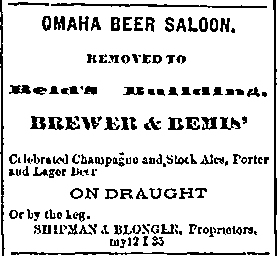
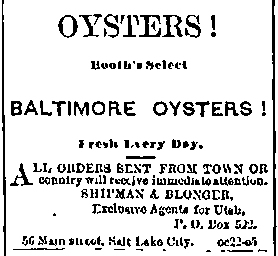
After Utah, the boys did try mining in Nevada, where they had saloons in Cornucopia, Tuscarora, and elsewhere. Sam was noted in 1876 as part owner of the Texas mine.
Wells-Fargo has never before turned up in a Blonger story, and this was not the type of job Lou seemed to undertake, though he was said by some to have been a teamster in Chicago right after the war. Sam, on the other hand, was said by Armstrong to have been a teamster during his first journey west, hauling freight between Sacramento and the boomtown of Austin, Nevada, traversing the Sierra Nevadas and the harsh Nevada desert, and stopping, one would suppose, to wet his whistle in Virginia City. Might he have hauled for Wells-Fargo? And might gold have been his cargo?
Here's the thing about Sam's first trip West, a trip that did apparently take place: Why not? The guy was in Colorado in 1861, and California in 1865. How could an adventurous young man of a willful disposition and no aversion to life in the fast lane not have real stories to tell? Just what did Sam do during the war?
I'm not done with Markey yet.
-CJ
|
| 8/4/2007 |
Simon Says
After four years in this business, I can say there are some fortunate aspects of researching the Blonger family:
1. The unique surname takes all of the frustration out of index searching (consider all the false leads you would take trying to hunt down someone named John Johnson).
2. Lou Blonger's public downfall makes contemporaneous newspaper accounts plentiful.
3. The brothers' multitude of mining claims left behind many public records of their whereabouts.
There are also some unfortunate aspects:
1. The Blonger brothers' unsavory lifestyle apparently caused the Belonger relatives in Wisconsin to scrub their story clean, leaving behind no remnant, save the Armstrong Account.
2. Having no living descendants (all lines of all five of the Blonger brothers are extinct) means no accounts, no photographs, and no artifacts in the hands of family members.
In other words, practically all of what we know about the Blongers comes from public rather than private sources.
We have copies of a few documents, written by others, but bearing the signatures of Lou, Sam, Joe, and Mike. But until this week, we had no item that was even remotely personal. That changed with a wonderful new contribution from Jim Jackson. Rummaging through his father's Forest Queen papers, he found two sheets of paper written in Simon Blonger's hand.
The two letters were written in 1895 and show Simon, in his position as superintendent of the Forest Queen, well on his way to turning it into a real mine. Just four years after its discovery, Simon and his crew had sunk the main shaft at least 80 feet into the side of Ironclad Hill. In one letter he describes the efforts of another set of lessors, working on a different shaft on the Forest Queen claim and wonders if they'll ever reach paydirt:
Cripple Creek 4/1-95
O W Jackson Esq
Denver
Dear Sir
Inclosed please find Statement of work don on Forest Queen Mine for month of March we quit work on the 28th having expended the four hundred Dollars agreeded upon we sunk the shaft 33 feet and drove the west drift on the 80 foot level 10 feet, in the shaft the ore looks about the same as the samples I sent down the drift is changing some looking better
the Leasors have started in an other place about 100 feet west of where they ware working I don't think they ever will strike the Pride of Cripple Creek Mine where they are working they may strike something else equally as good for they are getting some good looking quartz it is my opinion they are at least 200 feet west of the vein they are looking for. the Newport leasors have started to work
Mr Simmons is out of town as soon as he returns will sign the lease and I will send it back
Yours Respectfully
S R Blonger
In an earlier letter, Simon writes to his younger brother Sam, one of the co-owners, and wonders about a friend whose name may have been Fred Katz.
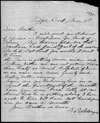
Cripple Creek Mar 1st 1895
Dear Brother
I will send you statement of Expences on Forest Queen for month of February Mr Harris told me that Jackson had paid his part of the essessment so did not think you wanted it sent to him
the vein is getting some wider and looking better we are not getting more than half as much Sulphate of Iron as we ware and more quartz and looking better every way
Sam are you cumming here on or about the first part of the month have you seen Fred Cattz [?] let me know how he is getting along I have wrote to him but have not hurd from him for over a month.
Your Brother as Ever
S R Blonger
One wonders how Simon must have felt about his situation. Three years older than Sam and 13 years older than Lou, he'd played the "big brother" role for over 50 years. He'd served a term in the Colorado House of Representatives, had been the superintendent of the Robert E. Lee Mine in Leadville, and apparently had operated his own lease on the Big Pittsburg Mine in that city. He was a self-made man, but now his younger brothers owned a gold mine, and he was working for them. How did he deal with that turn of events?
But back to the letters. Many thanks to Jim Jackson for sending them to us. Just as importantly, Jim, thanks for preserving them all these years.
-SJ
General Kearney
First let's take a look at the General. At first I wondered whether he meant General Kearny or General Kearney. Then I realized that, though there were two of them, their spellings were mutually interchangeable. Nobody seems to have a clue what's "correct."
Gen. Philip Watts Kearny (Kearney) died in 1862, at the Battle of Chantilly, days before Antietam. Curiously, Kearny was at the Second Battle of Bull Run, in command of the Army of the Potomac. Mike was there, too, with the 3rd Wisconsin. But Kearny would not have been shepherding emigrants across Nebraska.
Gen. Stephen W. Kearney (Kearny), on the other hand, died in 1848. Sam would have been nine, Lou was minus one and counting. This is from wikipedia:
By the early 1840s, when emigrants began traveling along the Oregon Trail, he often ordered his men to escort them across the plains so they could avoid attack by the Native Americans. The practice of military escorting wagon trains would become official government policy in succeeding decades. To protect the emigrants, Kearny established a new post along Table Creek near present-day Nebraska City, Nebraska. The outpost would be named Fort Kearny. However, the Army realized the site was not well-chosen, and the post was moved to the present location on the Platte River in central Nebraska.
So — no Kearney, or Kearny, though Sam probably did pass through Ft. Kearny, Nebraska as a young man. Documents we've seen indicate that by 1859 the Indians that settlers were encountering on the California Trail were more often destitute than dangerous. But there will be more to this story.
-CJ
|
| 8/5/2007 |
Bunco King Was A Sucker Himself
Back to Markey's article:
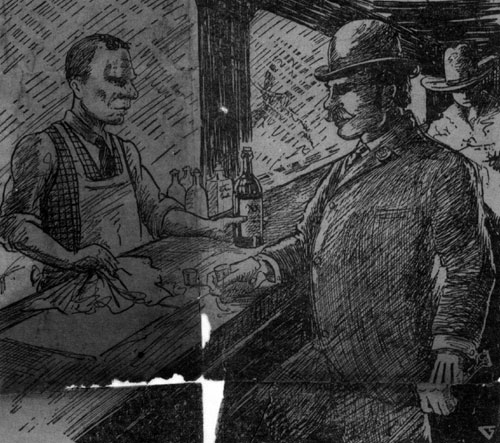
Some years later the brothers returned to Colorado. Denver, then an infant city, was the trading post for numerous mining expeditions which were headed toward mining communities of the state.
OPENED SALOON ON LARIMER.
Here they entered the saloon business on Larimer st., operating a wide-open gambling house in connection. In both games they were competitors of the famous "Soapy" Smith, whose fame as an out-and-out gambler was not limited to this state.
True enough. It can also be said they were partners in some enterprises and that the Blongers were underlings in others.
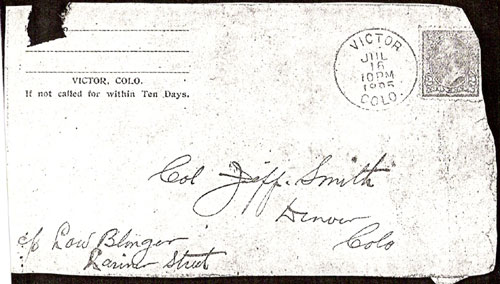
Despite ample earnings from this business the lure of hidden gold constantly beckoned to Lou and ofttimes he would take a vacation from his business to visit the new mining camps which were springing up about the state.
In 1891 the Iron Clad Hill district, several miles east of Cripple Creek, was opened. It was while visiting there that Lou, with W. H. Gibson, left the gaming tables and hiked into the hills on a prospecting trip.
They staked out several claims, among them one which Lou named the Forest Queen, in honor of his wife, who, prior to her marriage to him, was an actress and clog dancer. They were married at Tombstone, Ariz.
Another of their claims was the Newport, which they sold shortly afterward to a group of Colorado capitalists for $8,000.
The Jackson account would at least seem to render this story of the Forest Queen's discovery entirely plausible. How Cora Lyons, or her stage name, Nola, relate to the name "Forest Queen" is a mystery. You will see the name here and there — even other mines in other districts — so it may have been an honor to some other entity. I think it more likely the name was inspired by a very recent tragedy:
Aspen Weekly Times, February 27, 1892
Steamers Collide at Sea.
LONDON, Feb. 26—News of a terrible disaster in the North Sea, by which a steamer went to the bottom, carrying with her every soul on board, with only one exception, was received in this city at a late hour to-night.
Only meagre details of the catastrophe have been obtained, but from the dispatches already at hand it is learned that the steamers Loughbrow (British) and Forest Queen came into collision off Flamberough, a village of York county, east of Riding, on the North Sea.
So quickly did the Forest Queen founder that her crew had no chance to save their lives and all hands with the single exception of the captain went down to a watery grave.
The dispatches give no information as to the extent of the damage done to the Loughbrow.
In any case, no one else appears to have taken credit for poking around and actually locating the claim. Back to Markey:
The Forest Queen they retained. A third Blonger brother, Simon, then superintendent of the Robert E. Lee mine at Leadville, visited the Forest Queen and, after digging around, declared that the vein was sure to be a producer.
Simon and Joe would both work on the Forest Queen, for three dollars a day.

Some time after discovering the mine Lou had moved his saloon uptown, the first liquor establishment off Larimer st. His new place was located on Stout st., just west of the present site of the Equitable bldg.
That would be the Elite. The Blongers had at least six saloons and gambling joints between 1889 and 1896, not including the Elite. And they were all on Larimer but one, on Market between Sixteenth and Seventeenth.
While tending bar there one day he was visited by J. W. McCulloch of Owensboro, Ky., distiller of Green River whisky. During the course of conversation talk drifted to mining and continued on this line until Lou traded this distiller a one-fourth interest in the Forest Queen for 20 barrels of Green River.
As Blonger subsequently remarked to his patrons, "that should be wonderful whisky. It cost me enough."
McCulloch's one-fourth interest has paid to him and to his estate more than $200,000 and is today paying goodly dividends with no indication of immediate exhaustion.
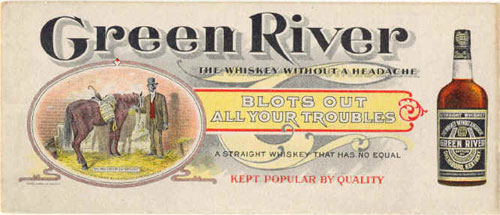
Blonger, according to friends, also gave away other shares in the property to friends, some of who still retain an interest.
The claim to the Forest Queen was patented in 1893 and was granted the fall of that year.
The claim was actually patented in March of 1892. The article then documents some of the mine's ownership history, which generally agrees with Jackson's data. Later, Markey quotes John Connors, a lessee of the Forest Queen, and perhaps a major source for these stories:
"Lou was always a friend of the man who was down, especially the miner. Whenever he was approached for a handout, he never gave the bum a dime or a quarter but a $5 or $10 bill," Connors said.
ANOTHER STORY OF BLONGER
Another anecdote told of Blonger was an incident which occurred a number of years ago. He was seated in a saloon in the window of which was a large tank filled with many kinds of fish. A customer in the place asked the proprietor, "What kind of fish is that big one lying on the bottom?"
"Oh, that's a sucker," was the reply. It was no sooner out of the bartender's mouth than Blonger was on his feet saying, "Let me at him."
Yuk, yuk. I like it though — gives that finger-to-the-side-of-the-nose cachet to the young con man in a way we rarely see, whether or not the quote is apocryphal. In any case it was the teller's way of revealing Lou's nature.
Still another one told on the occasion of one of the early-day excursions of tourists into Denver from Nebraska. Each tour had a director in charge.
One excursion train pulled into the depot and Blonger was on hand to meet it and see some of his Nebraska friends whom he knew were to be on it.
Much to his surprise, the director lined the excursionists up to give them directions as to where to stay and what to see and as a final shot added: "and keep away from Lou Blonger and his gang."
That one, I must admit, has the ring of truth.
Lou, Sam and Simon are dead but the name of Lou will be remembered in Denver by at least those of the present generation and the Forest Queen will be his monument after that.
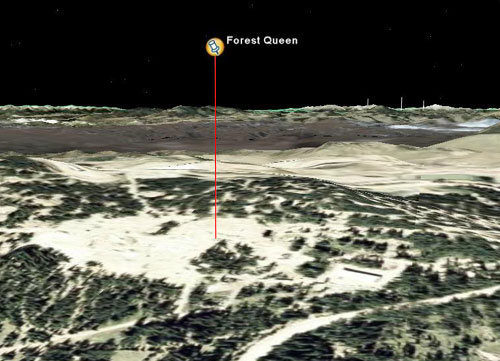
Well, at least they have a website.
-CJ
The Jackson File
Here are a few examples of the wonderful documents Jim Jackson has passed along.
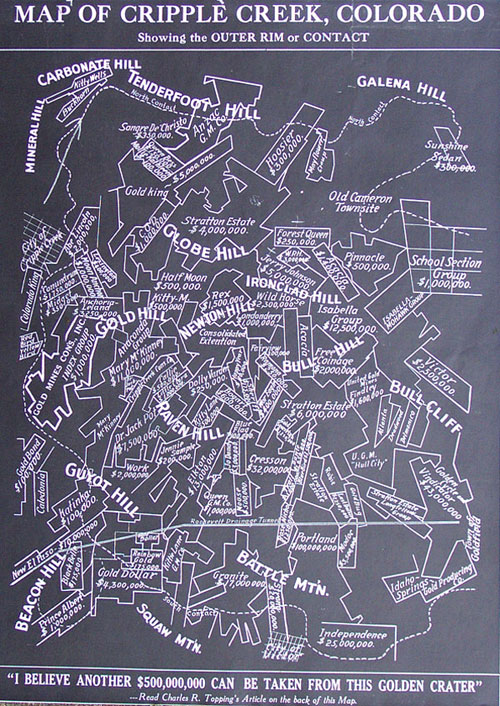
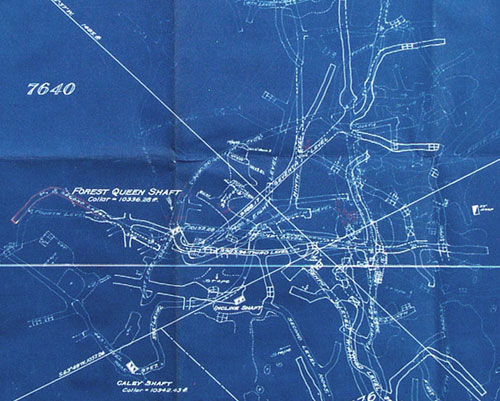
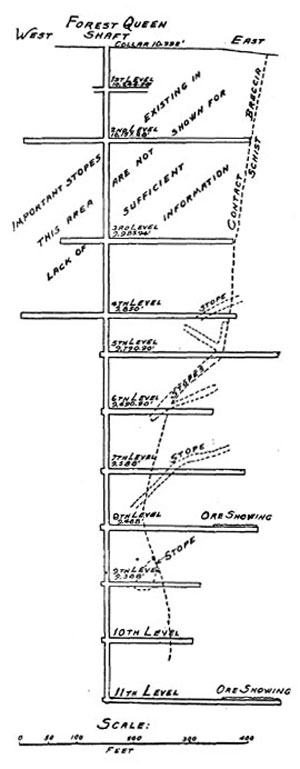
|
| 8/26/2007 |
The Jackson Files
More fantastic stuff from Jim Jackson. First, it's our pleasure to present the Forest Queen:
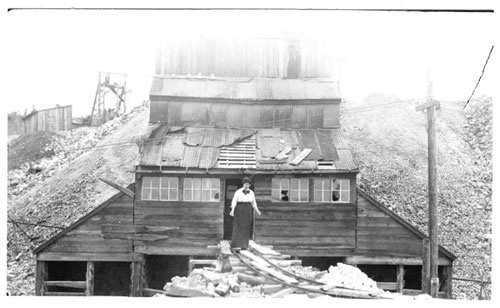
Ore House
Annie G Jackson [picture by J.O. Jackson] 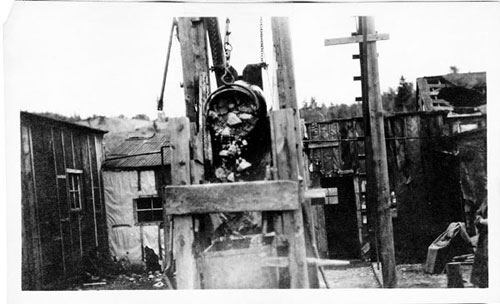
The ore bucket contents being dumped into a ore car.
[picture by J.O. Jackson] 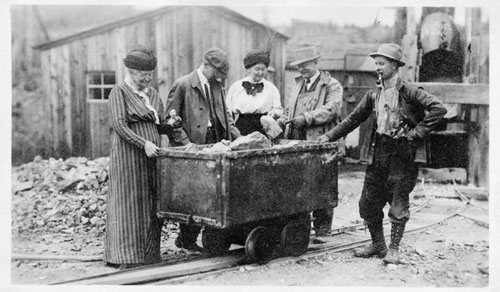
The ore being 'inspected'.
From left to right, Alice Givin, Robert J Jackson, Annie G Jackson,
John Connors and Fred Currie.
[picture by J.O. Jackson] 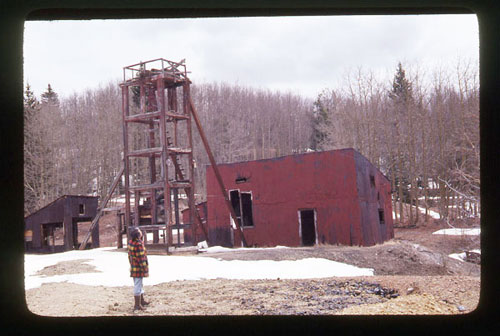
Headframe and winch house
Priscilla Jackson
[picture by Jim Jackson] 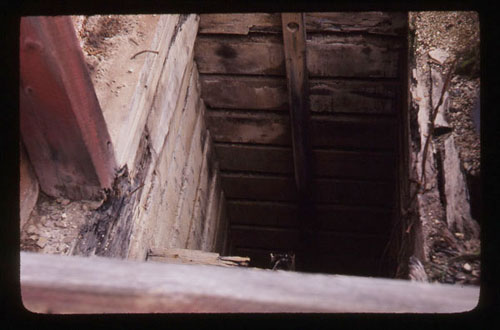
Shaft Opening
[picture by Jim Jackson] 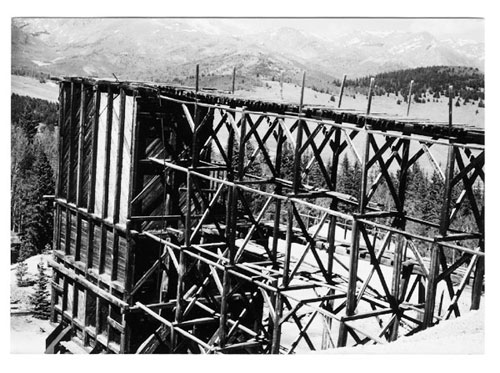
Ore House
[picture by Mr. Miller] -CJ
|
August 2007
|
Genealogy - History - Gang - Posse - Evening Review
The Grafters Club - Blonger Bros. Fake Restaurant
|
Copyright Notice: Original material copyright 2003-2021 Scott Johnson and Craig Johnson. Other copyrights may apply to materials found herein. Our primary goal is to reintroduce the Blonger Bros. to the lexicon of the Wild West. We therefore encourage the use of our research, provided due credit is given.
https://www.blongerbros.com
|
|



